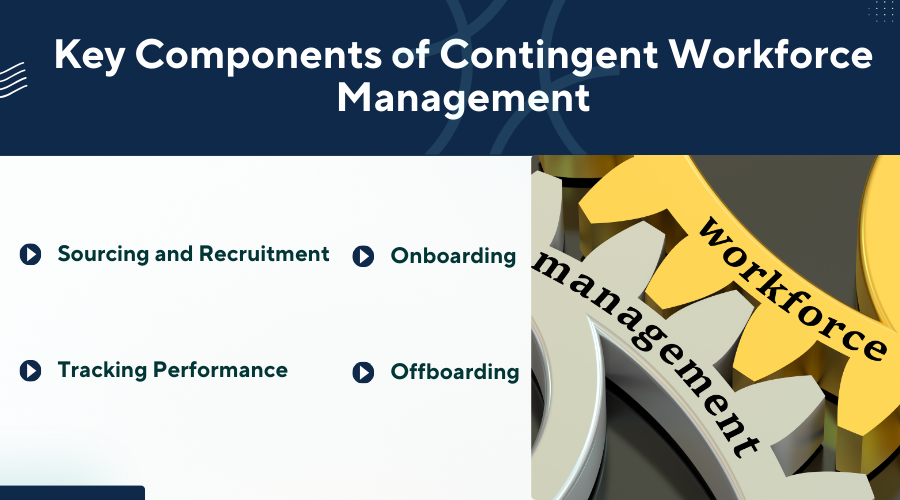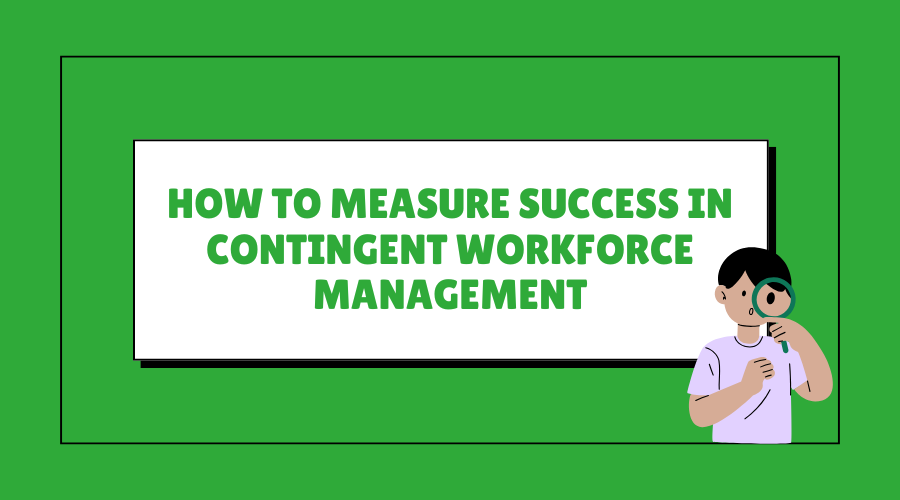
In today’s fastest evolving digital market, the way people do work is continuously changing. In the past, people used to rely on one full-time job for years, but today companies depend upon freelancers, part-time workers, and contractors to fill the skill gap and also to make progress faster; this is what we call contingent workforce.
If you own a digital business and are trying to set yourself apart from competitors, you shouldn’t just hire workers, instead, you should make a plan to manage all of them, and for this, a contingent workforce management guide can really help.
In this blog, we’ll discuss everything about what a contingent workforce is, how to manage them smartly, and what the best practices for managing a contingent workforce are that can save you from troubles and help to make progress.
What is a Contingent Workforce?
First of all, let’s define contingent workforce. Simply, it’s a group of non-permanent workers who are working in your company. They are those people you hire when you need them to carry out short-term projects, seasonal work, or some special skills you don’t have; they may include:
- Freelancers
- Independent contractors
- Consultants
- Gig workers
- Temps
So, contingent workforce management is a process of handling and managing non-permanent workers. These workers aren’t provided with the same benefits as full-time permanent employees, but in return, they get more flexibility and have free choice about who they work for, when, and how they are going to get the tasks done. Therefore, managing such workers needs a different kind of strategy that we’ll discuss in this contingent workforce management guide.
Why is Contingent Workforce Management Important?
You might be thinking— why do I need a whole plan for managing contractors and freelancers? Why can’t I just hire them for a task and pay them? Well, not really.
If you don’t take contingent workforce management seriously, things would get out of control, and you might end up with miscommunication, legal risks, missed deadlines, more revisions, or even losing money by hiring the wrong person. That’s why this Contingent Workforce Management Guide is a must-have if you’re working with flexible talent.
Key Components of Contingent Workforce Management

Now, let’s look at the key components of contingent workforce management that need to be in place if you want your business to run smoothly and make constant progress.
1. Sourcing and Recruitment:
The first step is to find the right people for the task, and it’s not simply about posting a job ad on freelancer sites. You’ve to know clearly what kind of skills you need, where you can find people with such skills, and how you can choose the right candidates. Good contingent talent management means you’ve to build a trusted network of freelancers, contractors, or agencies, from whom you can take help.
2. Onboarding:
We all know that contingent workers are temporary; they still need a proper welcome. A clear onboarding process is necessary to build a good relationship, which, as a result, keeps your business running. You should provide them with the necessary tools, share project timelines, and also introduce them to other team members.
3. Tracking Performance:
Without micromanaging them, you should track how they are getting the work done. Are they following deadlines and delivering quality work? You can use tools like project trackers to keep yourself regularly updated on what they are doing.
4. Offboarding:
Once they have completed their task, you should offboard them in a friendly way, provide them with feedback, also collect their reviews. This step might seem small, but it is a powerful part of contingent workforce management, and it is usually ignored.
Together, these four steps form the backbone of a system that works. With them in place, you’ll be ready to scale up or down as needed, without chaos.
Read More About: Retained Recruiter vs Contigency
Best Practices for Managing Contingent Workers
Now, you clearly know the structure, but what really matters is your method of managing the workforce. So, let’s talk about the best practices of contingent workforce management guide when you’re handling contractors, freelancers, or temps. If you follow this guide, you’ll save yourself from constant stress and headaches.
Set Clear Expectations From Day One
Miscommunication is one of the leading causes of the failure of any business, isn’t it? When roles, timelines, or projects aren’t explained thoroughly, it leads to more mistakes because companies assume that the contractor will get everything without explanation. Therefore, make sure to spend a little time on your contractors before they start their work:
- What exactly needs to be done
- How success will be measured
- When it needs to be completed
- Who they should go to with questions
Communicate Regularly
A lot of people think that contingent workers want to be left alone, but if you do regular check–ins and frequent updates, they don’t mind. This doesn’t mean you have to keep an eye on their every micro task; you just have to communicate with them freely so that they don’t feel left out. A lot of businesses forget this, but open communication is one of the most underrated contingent workforce management guidelines out there.
Make Them Feel Part of the Team
You should make them feel like their work matters to you. Just because they’re not full time workers doesn’t mean they should be ignored. Make them feel included and give them so that they keep themselves engaged and perform better.
You can:
- Introduce them to your internal team
- Invite them to relevant team meetings
- Appreciate their good performance publicly
Give Feedback (And Ask for It Too)
Feedback is very important for everyone because if you give feedback, either good or bad, it helps the other person improve their performance. You should also ask them to give their feedback about you as a client. This step will make future projects with the same people easier because people know you care about them.
Use Tools That Keep Everyone Aligned
A lot of the stress in managing contingent workers comes from poor coordination. To keep yourself safe from such stress, make sure to use the necessary tools like Google Doc, Slack, etc, which keeps everyone aligned and reduce confusion while speeding up decision making.
Respect Their Time and Scope
Contingent workers usually deal with multiple clients. So avoid the trap of treating them like they’re on-call 24/7. Respect their work hours and avoid pushing tasks that fall outside the agreed scope unless you’re willing to adjust timelines or pay. That’s just fair—and keeps the working relationship healthy.
Build Long-Term Relationships
One of the smartest moves in contingent workforce management is building a go-to list of trusted contractors. When you treat your external workers well, they’ll want to work with you again. You won’t have to start from scratch every time you need help.
How to Measure Success in Contingent Workforce Management

So, you’ve chosen the workforce, followed the best practices, and your team is using more freelancers and contractors than before. But, how do you know it’s actually working?
Well, a lot of companies skip this part. They create the process but don’t check if it’s helping the business or not. So, it is also necessary that you measure the success of your contingent workforce management guide, and without it, you’re kinda just guessing.
1. Track Cost Savings
Of course, one of the biggest reasons companies use contingent workers is to save money. But, make sure you just don’t look at their hourly rate; instead, measure it thoroughly:
- How much time did you save in recruitment?
- Did you avoid paying benefits or long-term overhead?
- Were you able to complete a project faster?
Even if a freelancer’s hourly rate is higher than an employee’s, if they get the job done faster and better, you’re not at a loss because, in return, you’re getting quality work much faster.
Therefore, keep a running log of total spend per project and compare it to similar work done in-house. This gives you a fair view of cost-effectiveness.
2. Look at Quality of Work
This one’s huge. A cheaper contractor isn’t worth it if the work needs so many revisions. One way to measure quality is through regular feedback, both from managers and coworkers who worked with the contractor.
You can also create a simple rating system (like 1–5 stars) to score things like:
- Communication
- Skill level
- Deadline delivery
- Overall results
Over time, this helps you figure out which types of workers and roles are adding the most value. It’s a key part of smart contingent talent management.
3. Measure Project Completion Time
A lot of teams bring in contingent workers during their hard times. So a good question to ask is: Did their involvement speed things up?
Compare how long similar tasks or projects took with and without contingent help. If freelancers are helping your team move faster without burning out full-time staff, you’re doing it right.
4. Track Contractor Retention and Re-Engagement
This one’s easy to miss. But if you’ve got freelancers or temps who come back again and again, or who want to work with you again, it means they had a good experience working with you. That’s a positive sign for your contingent workforce management efforts.
Repeat engagement also means less onboarding time in the next round when you need them. It saves energy, builds trust, and helps you maintain a steady talent pool.
5. Gather Feedback From Everyone Involved
Don’t just look at the numbers. Ask people how it felt to work with contingent talent.
- Did full-time staff feel supported?
- Were expectations clear?
- Did the contractor or freelancer feel welcome and set up for success?
Simple feedback surveys (even informal ones) help solve small issues before they turn into big problems. It also helps you improve how you’re managing contingent workers next time.
6. Monitor Compliance and Risk Management
Success isn’t just about saving time or money, it’s also about avoiding mistakes. Are your contingent workers properly classified? Are contracts and legal terms in place?
If you’ve made it through a quarter with no compliance issues, that’s a very good thing. It means your contingent workforce management guide is working; that’s why you are getting results.
7. Keep an Eye on Team Dynamics
Last but not least, watch how your main lead team responds to working with contingent staff. If collaboration is smooth, morale stays high, and work gets done, it’s awesome. But if tensions rise or confusion is created, it might be time to adjust how you’re integrating contingent roles.
A great contingent workforce management guide doesn’t just focus on workers—it supports your whole team.
Conclusion
So, now you’ve all the information about the contingent workforce management guide, you should have a clear idea about what, why, and how you can handle a flexible team.
In today’s changing work world, more and more companies are turning to freelancers, temps, contractors, and consultants to fill gaps and bring in fresh skills. But just hiring them isn’t enough — managing contingent workers the right way is what really makes the difference.
When done right, contingent workforce management can help you cut costs, stay productive in the long run, and get projects done faster. But without a proper plan, things can really become opposite, and your efforts might get wasted, like miscommunication, missed deadlines, or even legal trouble. That’s where best practices come in, from clear onboarding to regular feedback and smart tech tools, every step is important.
Whether you’re just starting out or looking to improve your current system, this guide gives you a solid base to build a contingent workforce. Use what fits your business, keep learning, and always keep your people — even temporary ones — in mind. Because, in the end, success in contingent talent management comes from treating every worker with clarity, respect, and purpose.
Hope this guide helped clear things up and gave you some useful ideas to apply. The workforce might be changing, but with the right approach, you’ll be ready for it.

